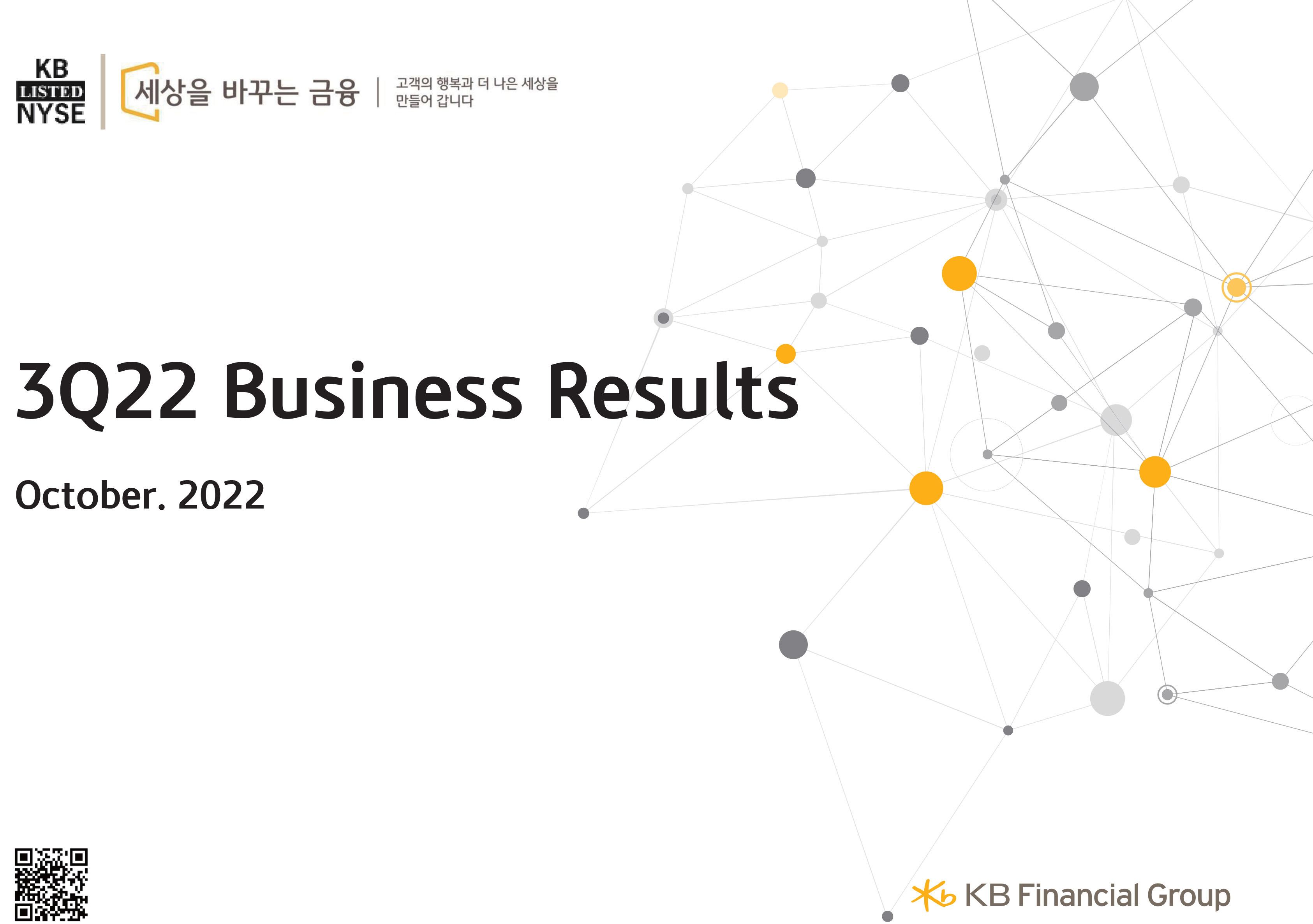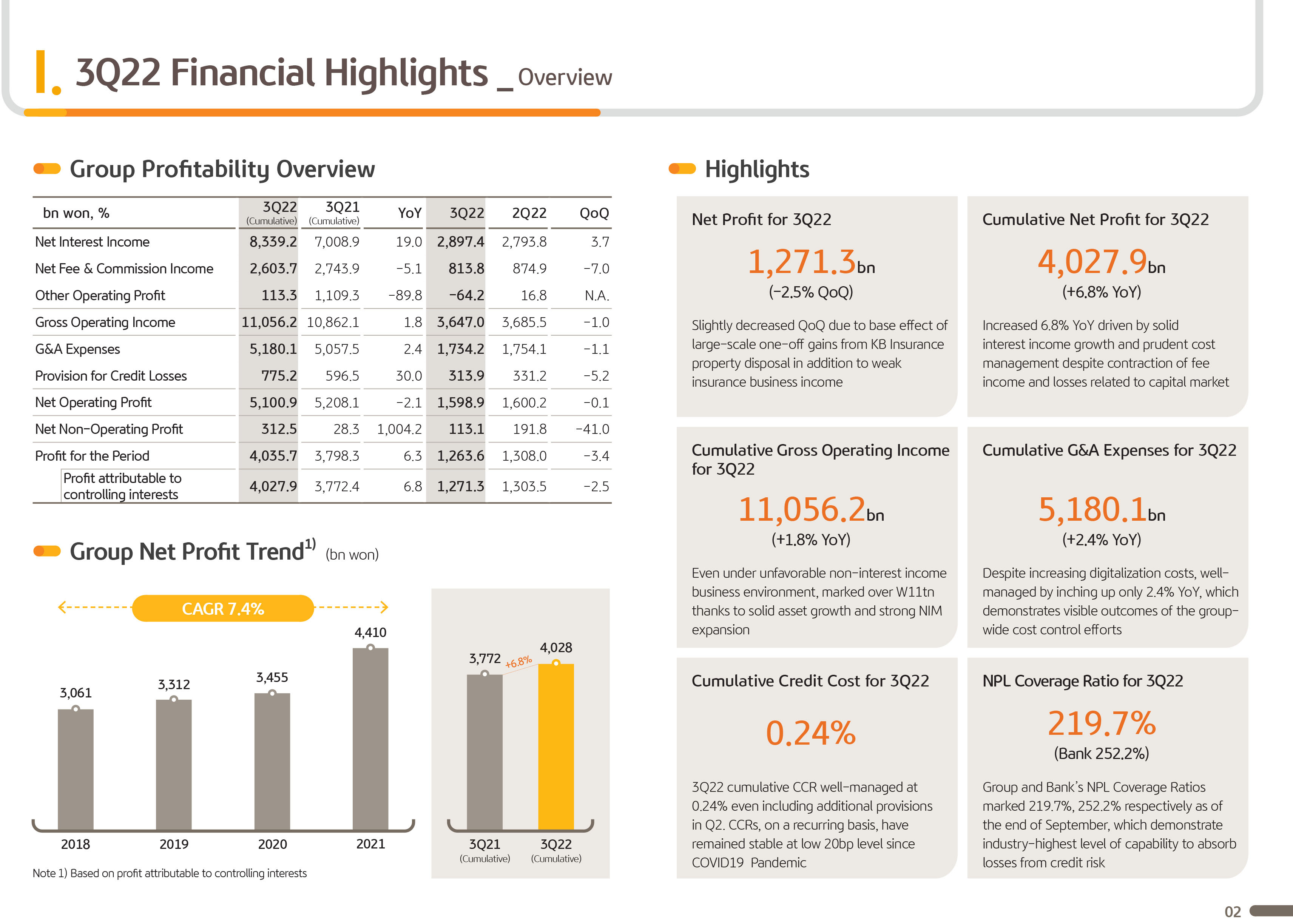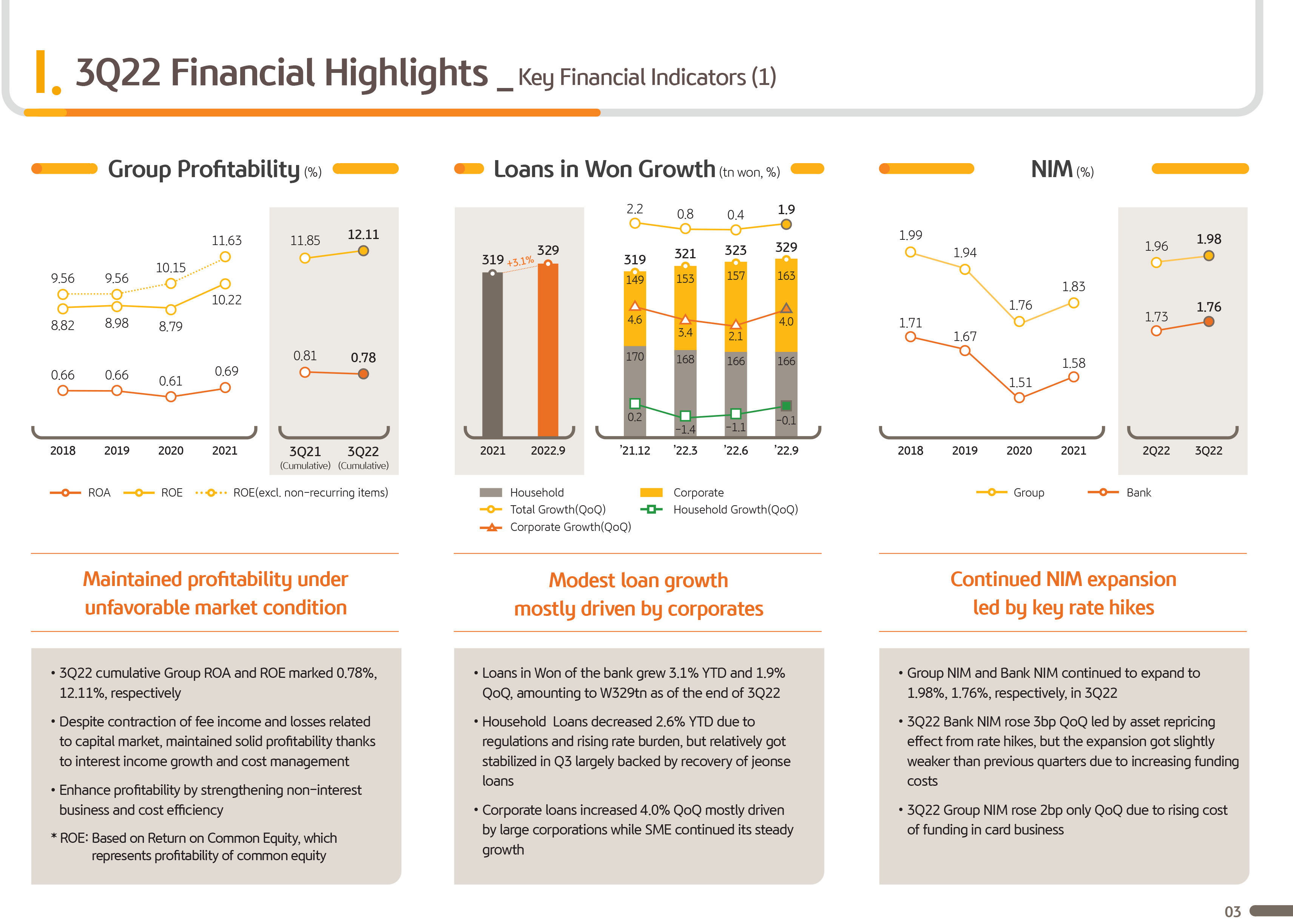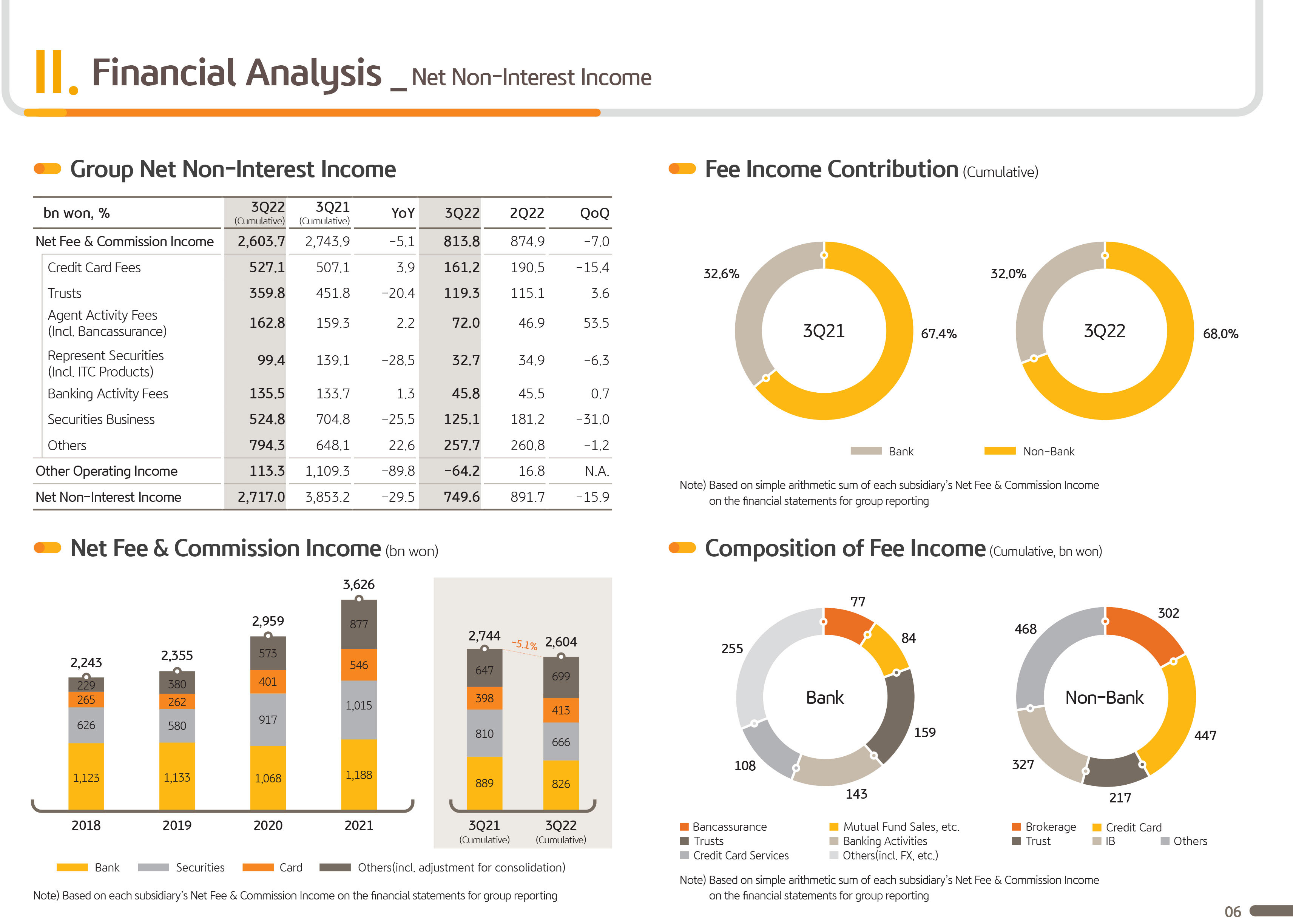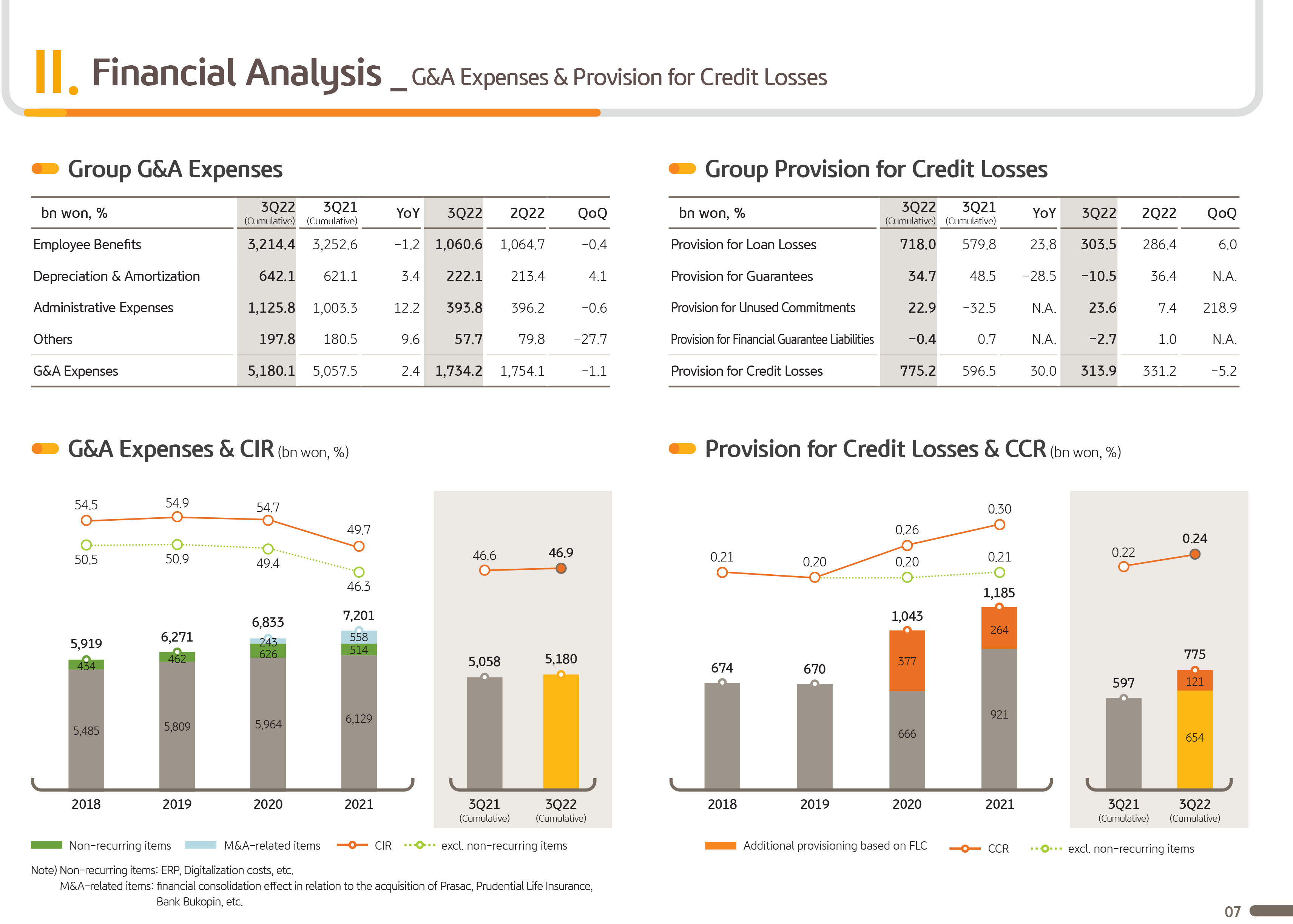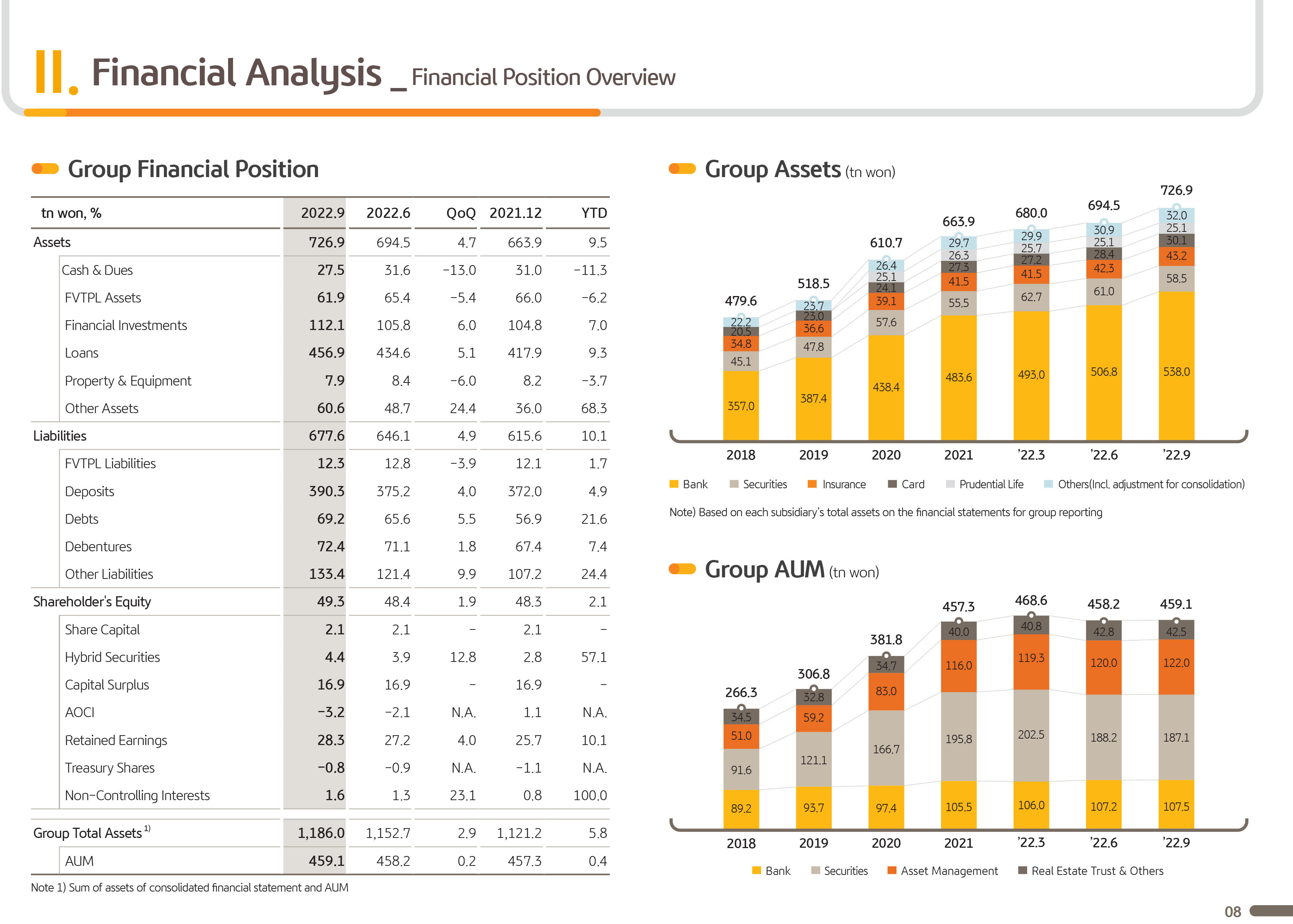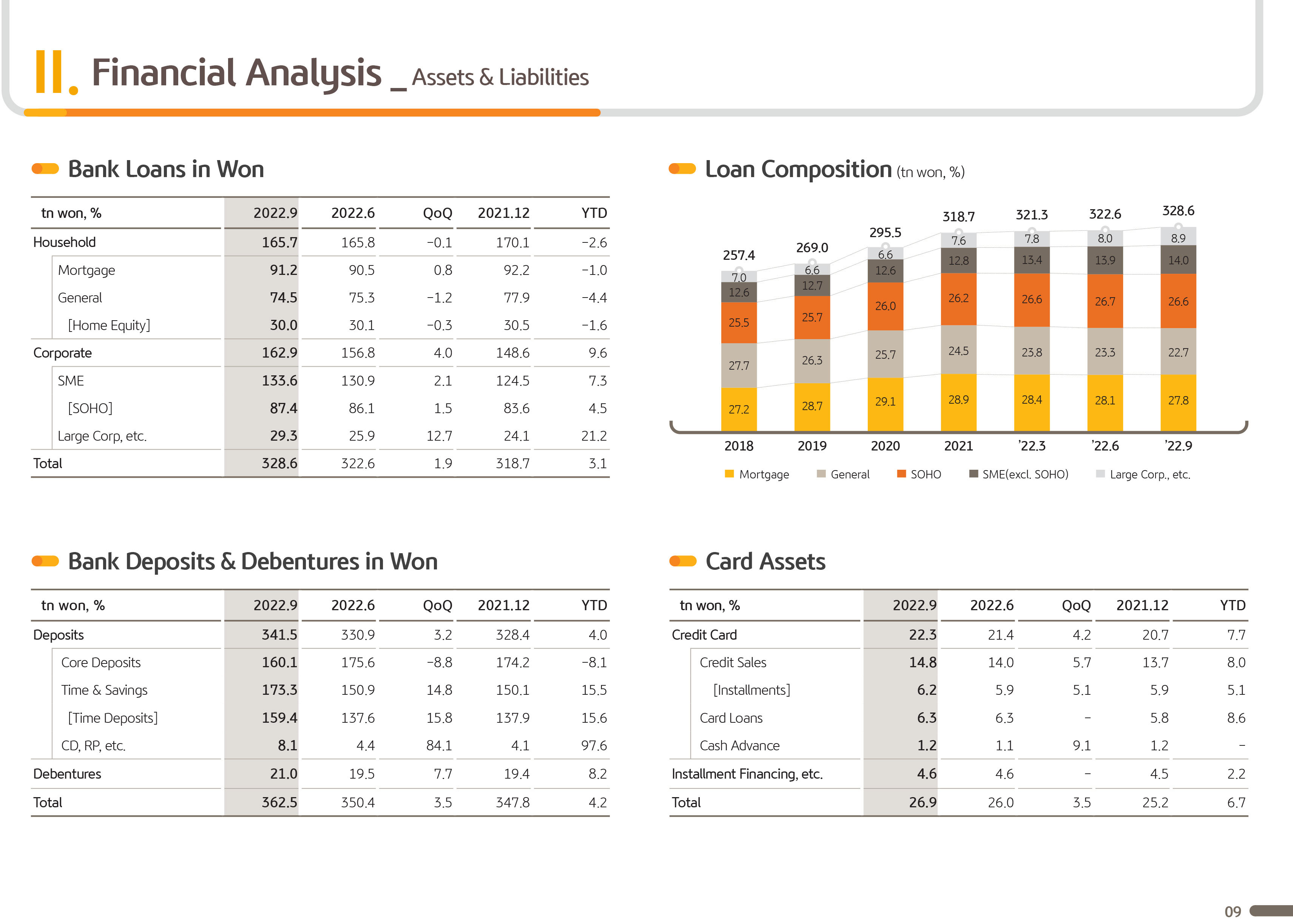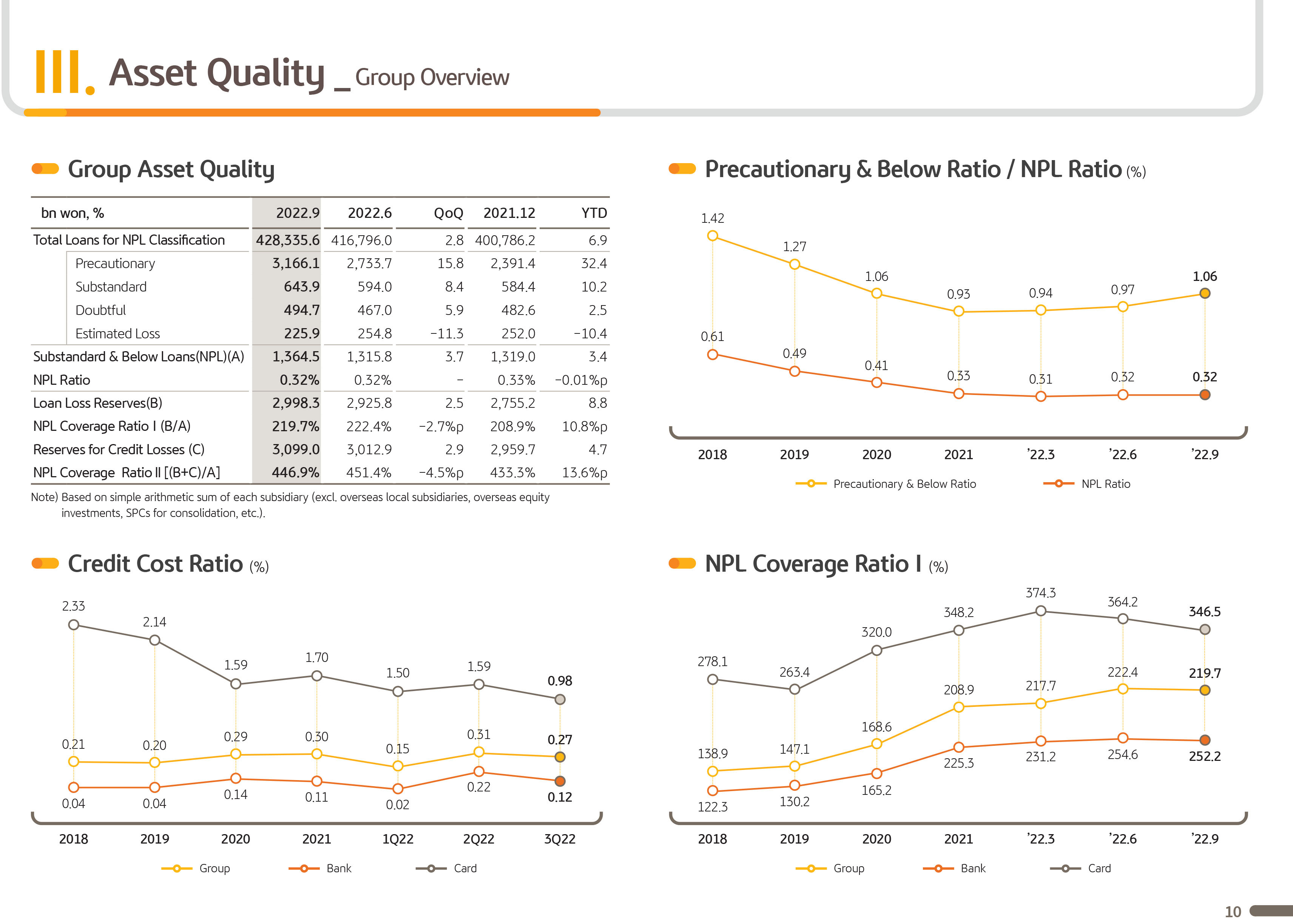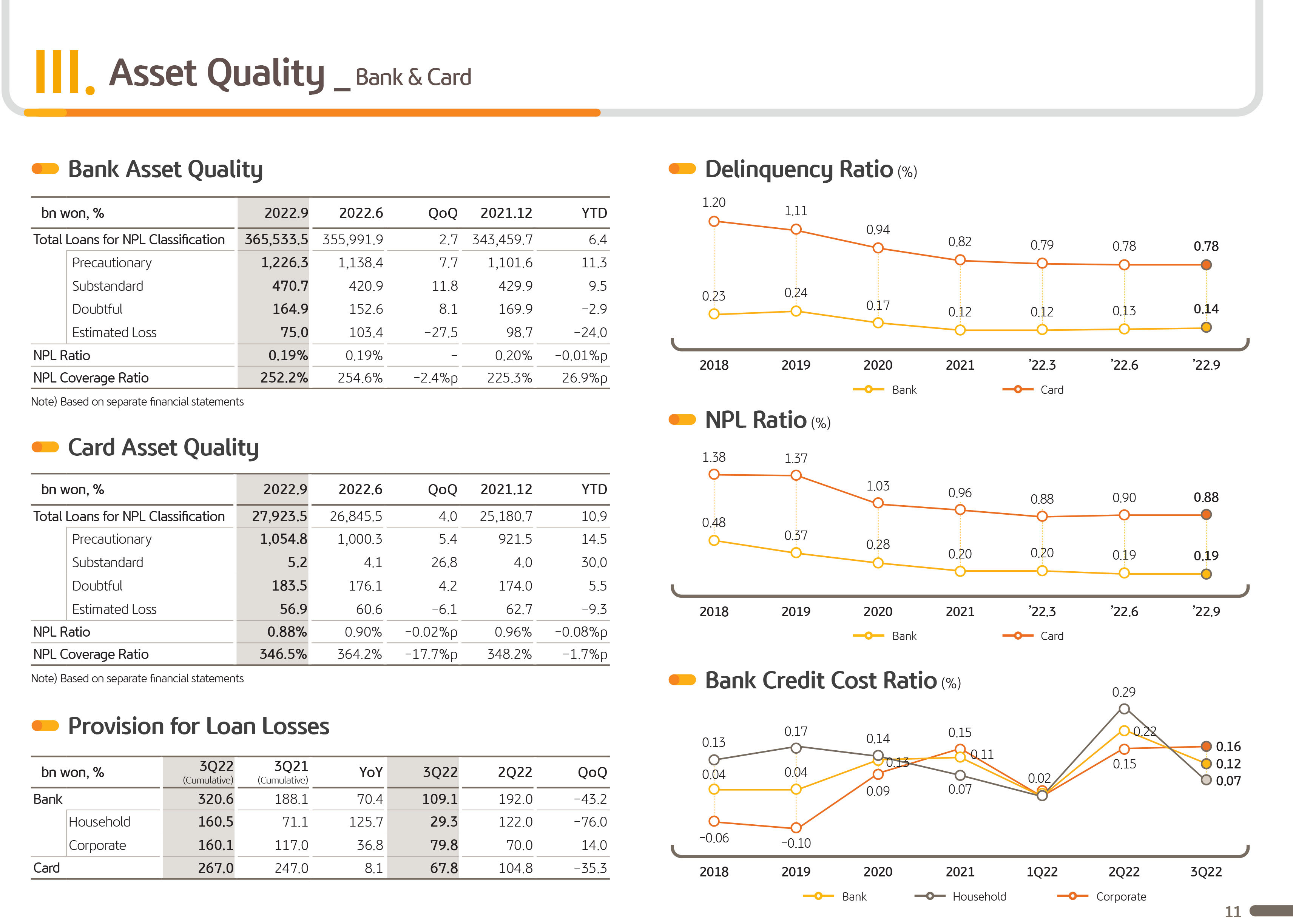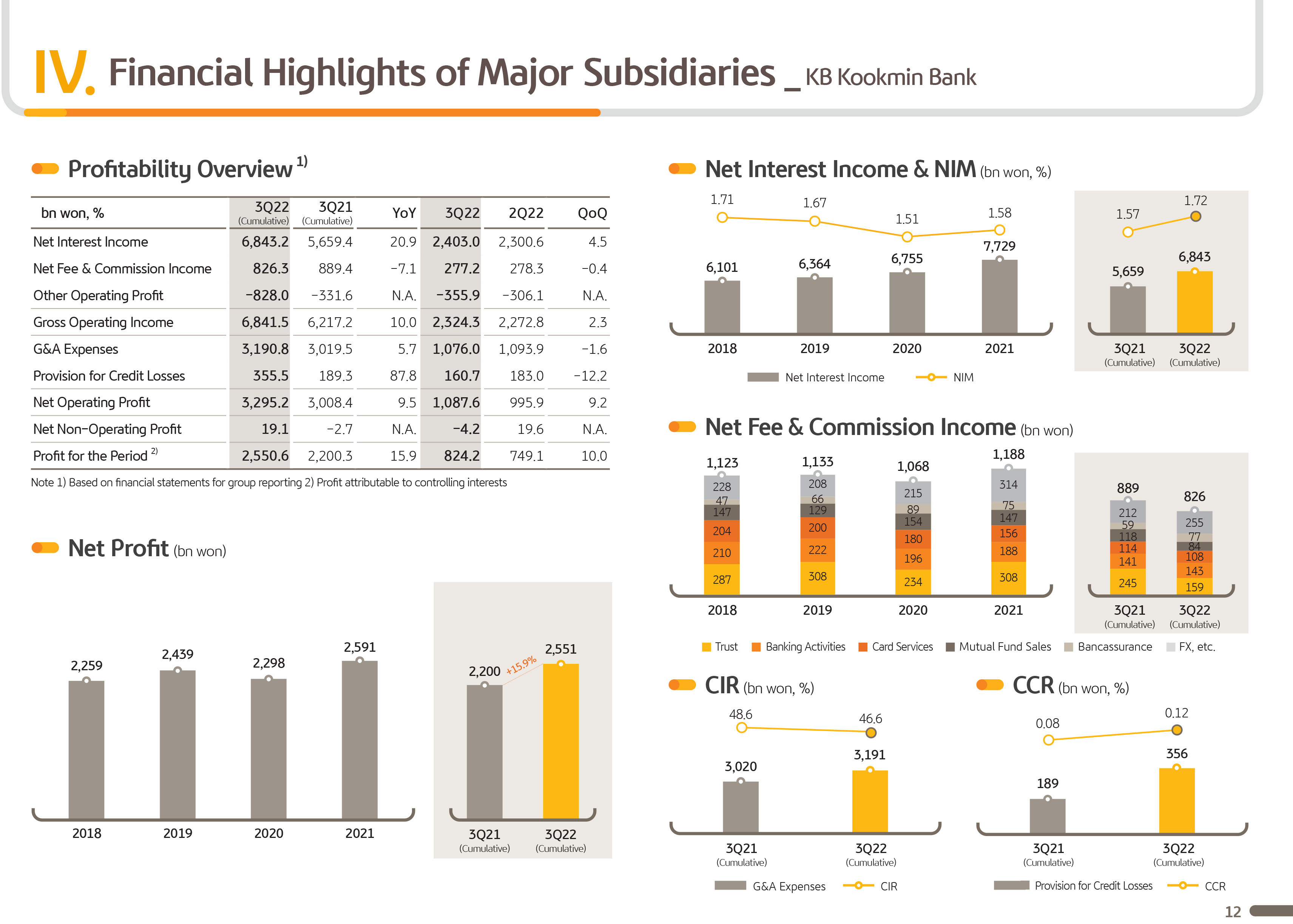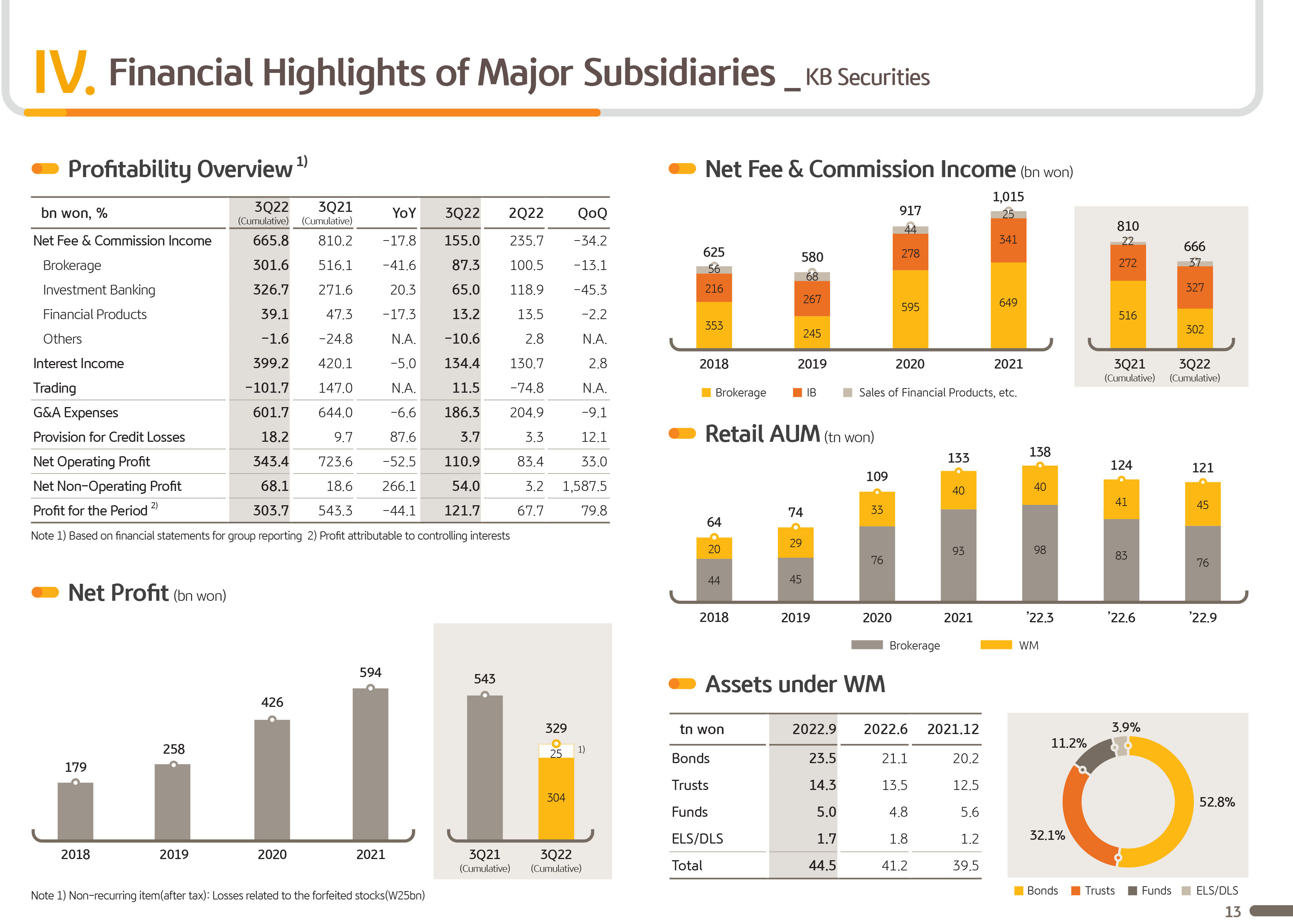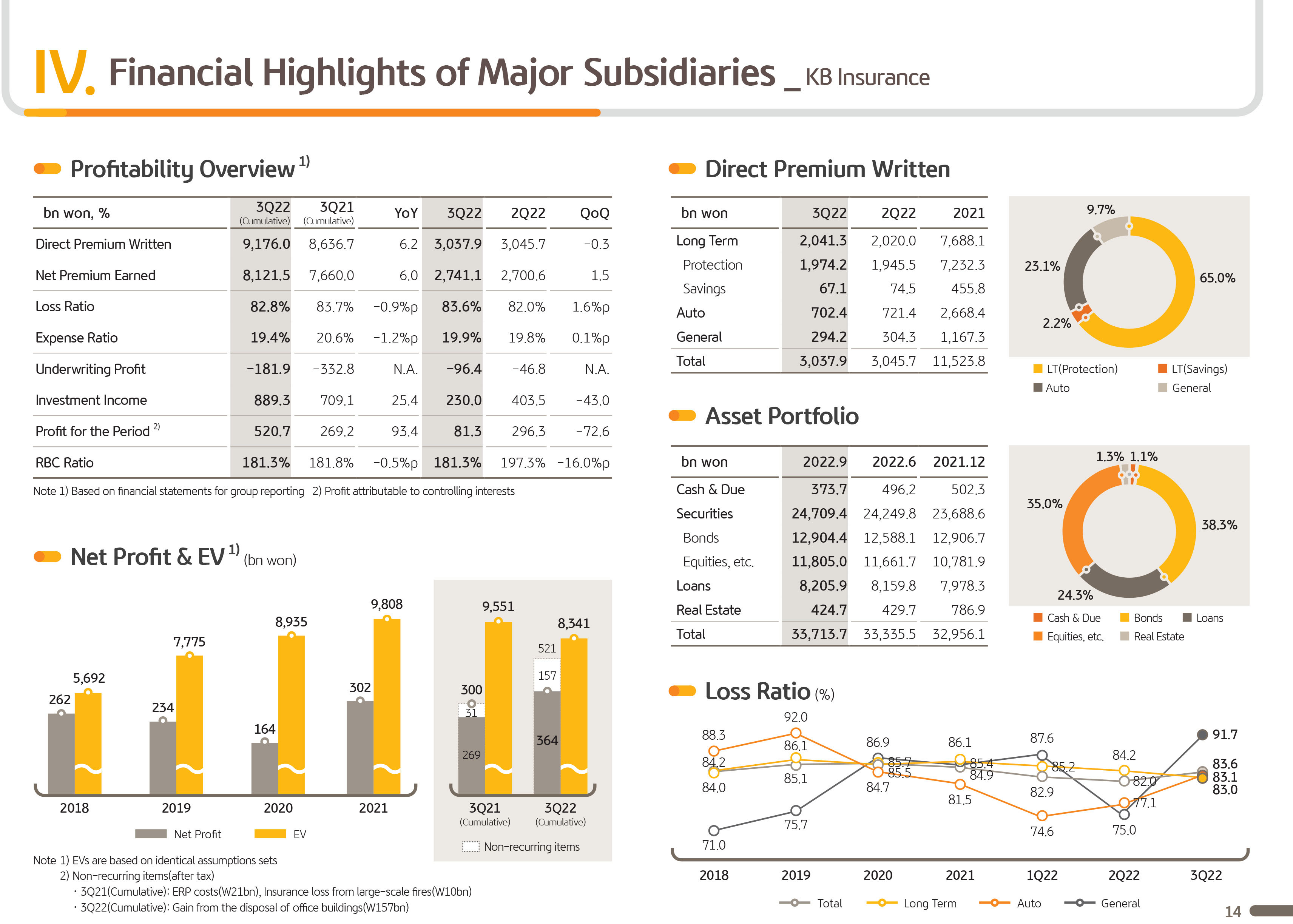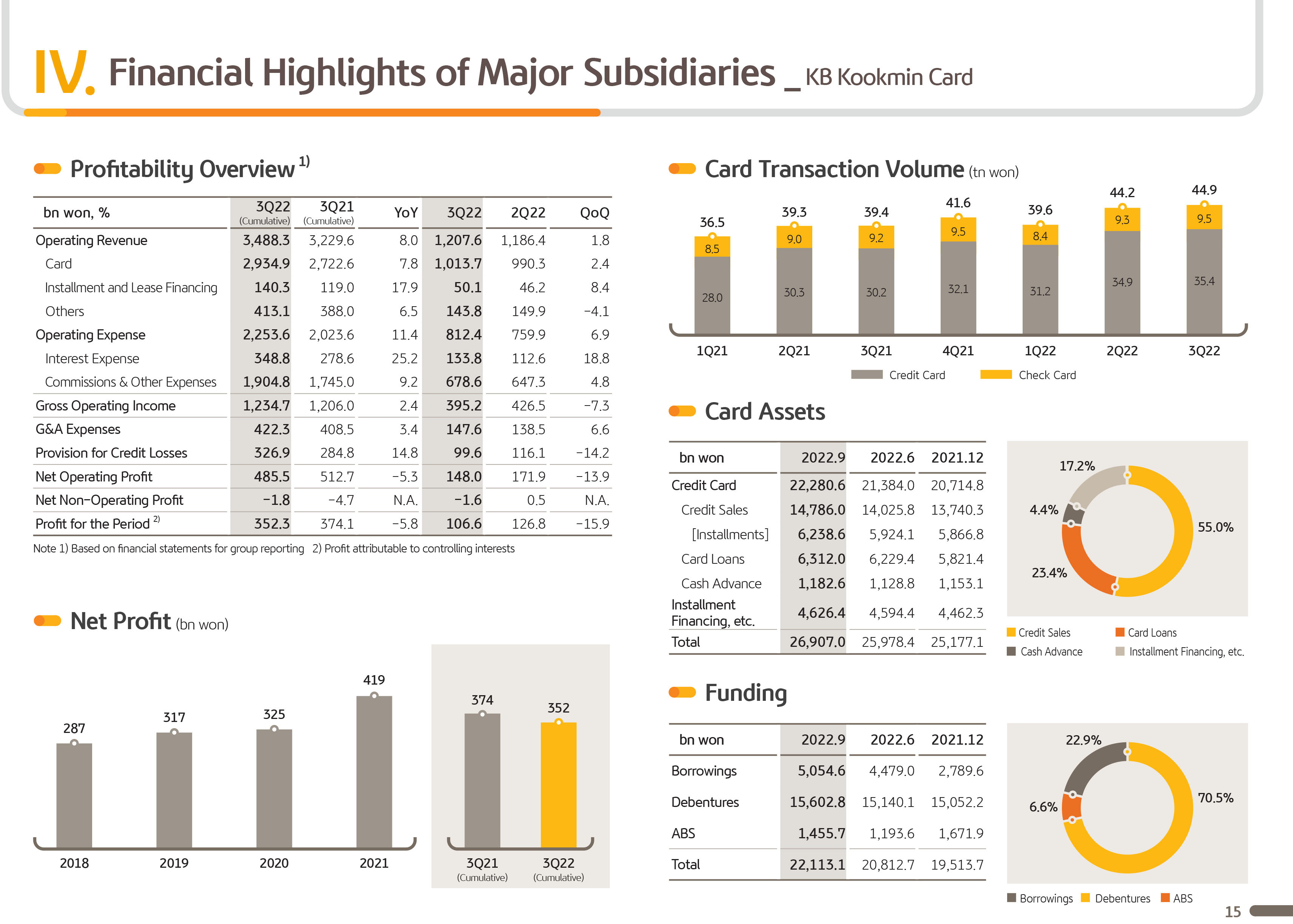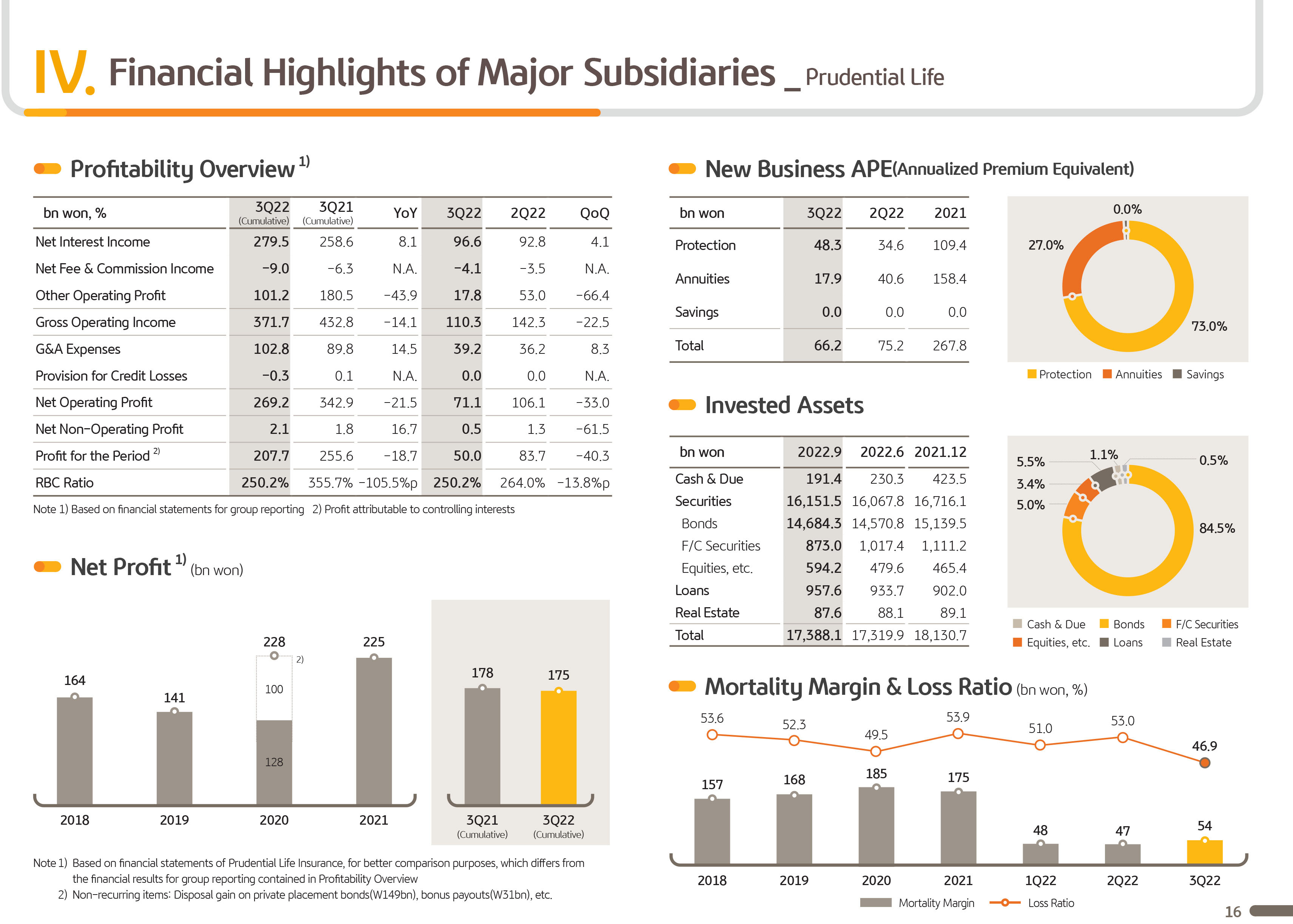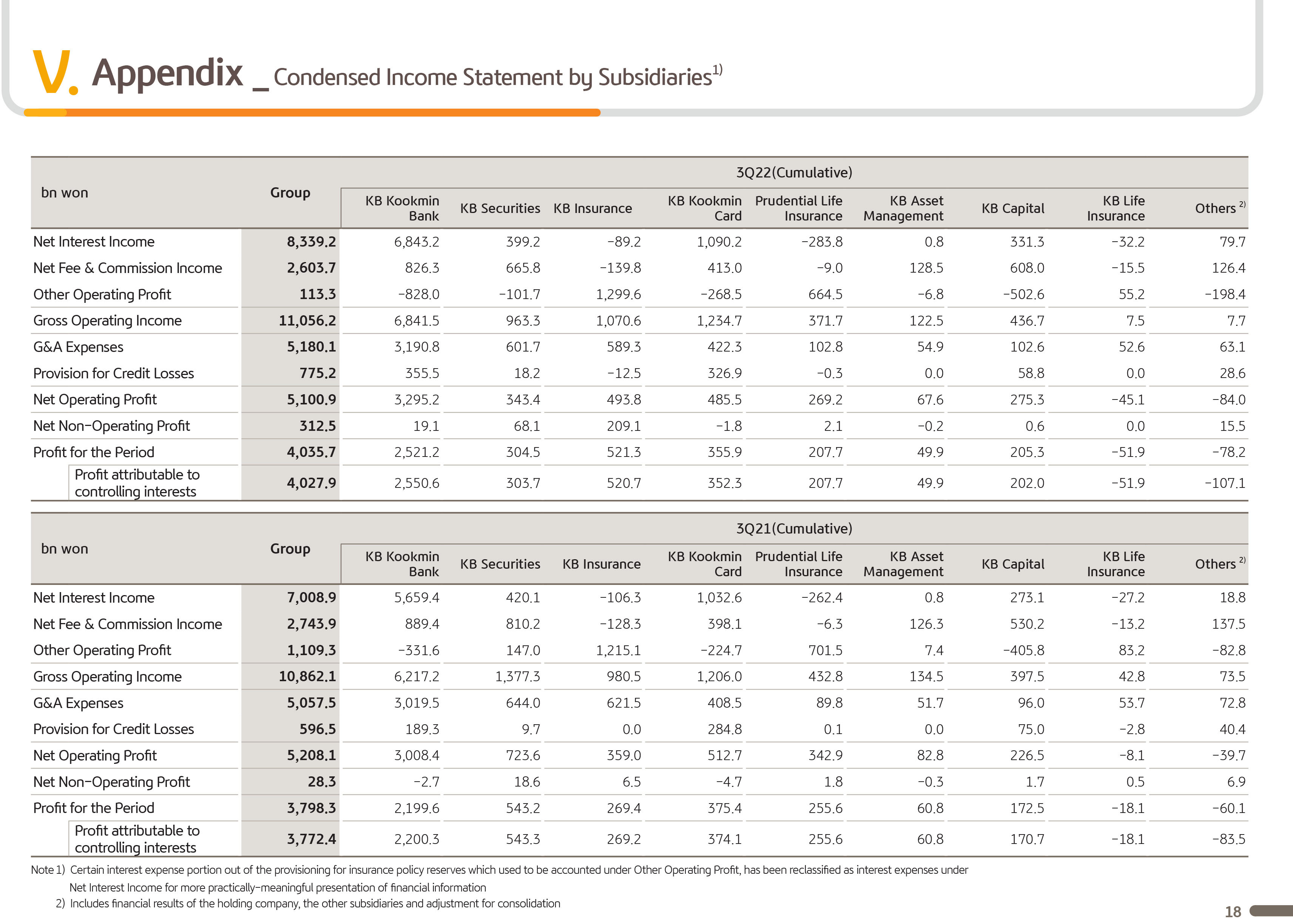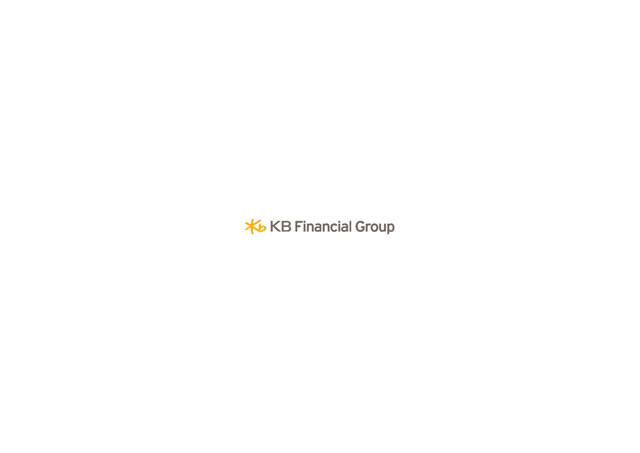-
Please adjust the volume.
3Q22 Business Results
Greetings.
I am Peter Kweon, the Head of IR at KBFG. We will now begin the 2022 third quarter earnings release. I would like to express my deepest gratitude to all of you for participating. We have here with us today at our business results presentation Scott YH Seo, Senior Managing Director and CFO of the group; as well as other group executives. CFO, Scott YH Seo, will first present the Q322 major business highlights, and then we will have a Q&A session. We will invite our CFO to walk us through the Q322 earnings results.
Good afternoon. I'm Scott YH Seo, CFO of KB Financial Group. Thank you for joining the company's Q322 earnings presentation. Before going into earnings results, I will briefly run through key business highlights of the group.
First, KBFG's Q322 cumulative net profit was KRW 4,027.9 billion, up 6.8% YoY. Despite greater financial market volatility and difficult operational backdrop, we once again displayed the group's robust fundamentals and earnings capacity.
Also, cumulative ROE reported 12.1%, and annualized EPS, earnings per share, was KRW 13,530. EPS was up 5.9% YoY, sustaining an uptrend. Q322 net profit was KRW 1,271.3 billion, seeming to have dipped marginally versus Q222. But excluding one-off gain from sale of real estate from KB Insurance last quarter, KBFG's headline profit was up 7.7% QoQ.
Next, Q322 cumulative credit cost for the group against total loan was 24 basis points. Despite slower global demand, trade deficit and heightened uncertainties in the real economy as well as deep rate hikes leading to higher credit risk, we have been keeping credit cost at a steady level at around 20 basis points, which KBFG has maintained since 2016, while group's NPL coverage ratio as of end of September was around 220%, which is the highest level of loss absorption capacity in the industry.
Lastly, KBFG's BOD today has decided on KRW 500 quarterly dividend pay per share.
Let me now walk through the details of the business performance. Q322 cumulative net interest income for the group was approximately KRW 8,339 billion, and net interest income for Q322 reported KRW 2,897 billion. Driven by solid loan asset growth and higher NIM on a rate hike cycle, it was up 19% YoY and 3.7% QoQ.
Group's Q322 cumulative net fee commission income reported around KRW 2.6 billion. On the back of stock market slump, driving a significant fall in trading volume, brokerage fee income from the securities entity was down by around 42% year-over-year, and we also saw sluggish sales of trust and funds for the bank.
However, on the other hand, due to our multifaceted efforts in enhancing competitiveness in the Group’s IB business, we are also seeing remarkable results such as a rise in fee commission income up by 56% YoY. We expect our dominance in the IB market will further expand and contribute to strengthening the group fundamentals.
Also, Q322 net fee commission income was KRW 813.8 billion. With the slump in the overall stock market, securities business fee commission income contracted, declining 7% QoQ.
Next is other operating profit. Other operating profit in Q322 was somewhat sluggish due to variabilities in seasonal profit from insurance entities. There were heavy rainfall, typhoon and other seasonal factors and large fire this quarter, leading to an increase in loss ratio of the insurance business and lower investment gains, including dividend income.
But this quarter, there was marginal QoQ improvement in Q322 performances from securities, derivatives and FX, especially in September, despite unprecedented level of capital market volatility this quarter. Through a diversified investment portfolio and elastic positioning strategy, we were able to nimbly and efficiently respond to the market.
Next is on G&A expense. Q322 cumulative G&A was approximately KRW 5,180 billion. Despite higher digitalization investment, thanks to sustained operational revamping efforts and group-wide cost controls, cost increase was well kept at 2.4% YoY.
In particular, in the face of concerns of a recession next year, disciplined cost control will be the priority for the business. Hence, we will revisit all of the cost items starting from a zero basis and not lose focus on group-wide cost controls.
Lastly, the group's provision for credit losses. Q322 cumulative provision for credit losses posted around KRW 775 billion and increased KRW 179 billion YoY. This was due to around KRW 121 billion of additional provisioning in Q222, reflecting a conservative forward looking scenario. And excluding this, this is generally at a level which meets the increase of the group's loan assets.
On the other hand, Q322 provision for credit losses posted around KRW 314 billion. And due to the additional provisioning base effect in Q222, decreased slightly QoQ.
I will cover the key financial highlights from the next page.
First, please look at the bank loans in won growth graph in the middle. Bank loans in won as of end September posted KRW 329 trillion and grew 1.9% compared to end June and increased 3.1% YTD. Corporate loans posted KRW 163 trillion. And SME loans and large corporate loans saw balanced growth, respectively. And with the 9.6% and around KRW 14 trillion growth YTD, corporate loan is leading the bank loan growth.
In particular, in Q322 alone, there was a 4% growth compared to June end. And it was attributable to an increase in large corporate loans by KRW 3.4 trillion, which was led by rising loan demand due to a contraction in the corporate bond issuance market.
In the case of household loans, with the steep increase of loan interest rate and effect from loan regulations,loan demand decreased and repayment continue leading to a 2.6% decrease YTD and is generally sluggish. But in Q322, jeonse loans recovered and increase of around KRW 900 billion. And with Citibank unsecured loan conversion demand coming in, reverse growth pressure greatly went down.
Next is net interest margin, NIM. Q322 group NIM and bank NIM each posted 1.98% and 1.76%, respectively. And Q322 bank NIM increased 3bp QoQ. With the decrease of low-cost deposits and great surge of time deposits, funding cost burden increased. And compared to the first half of this year, the rate of increase is limited. But with the asset repricing reflecting the interest rate hike, it is still maintaining an expansionary stance. For your reference, Q322 group NIM reflected the card business funding cost rise and grew 2bp QoQ.
Let's go to the next page.
First, the group's cost effectiveness. The cost-to-income ratio Q322 cumulative group CIR posted 46.9%, and the recurring CIR, excluding one-off factors such as digitalization costs, posted a 45.7% level. The group's cost efficiency is showing a very visible improvement trend due to solid top line growth, group-level headcount structure improvement. And as a result of cost management, in the mid-to long term, the group's CIR aims to reach the low to mid-40% level.
Next, is the credit cost. As mentioned earlier, the Q322 cumulative group credit cost is still low at 24bp compared to total loans. In particular, even in a situation where risks have increased due to COVID-19 pandemic and rising interest rates, the group's recurring credit cost has been stably being maintained at the early 20bp level from 2020 to the present. It can be said that this proves our conservative asset quality management policy and preemptive risk management capabilities.
Finally, I will cover the group's capital ratio. As of end September, the group BIS ratio is 15.42%, and the CET1 ratio is 12.60%. With risk-weighted asset increase due to corporate loan-centered growth and overseas asset expansion and accumulated other comprehensive income decreased due to interest rate hikes and stock price decline, BIS ratio decreased compared to end June, but still a solid capital buffer is being secured against macro uncertainties.
From the next page,
we have detailed results regarding the business performance I've described so far. This concludes KB Financial Group's business performance report for the third quarter of 2022.
Thank you for your attention

